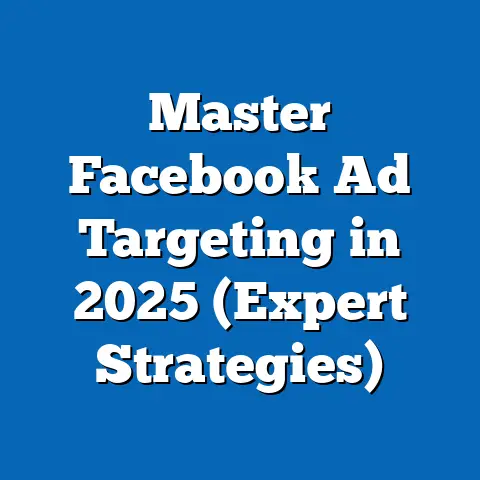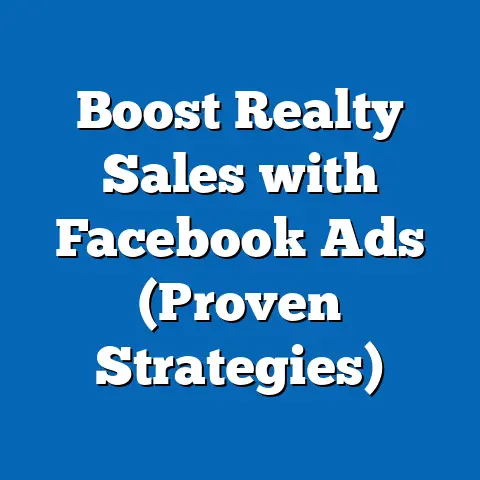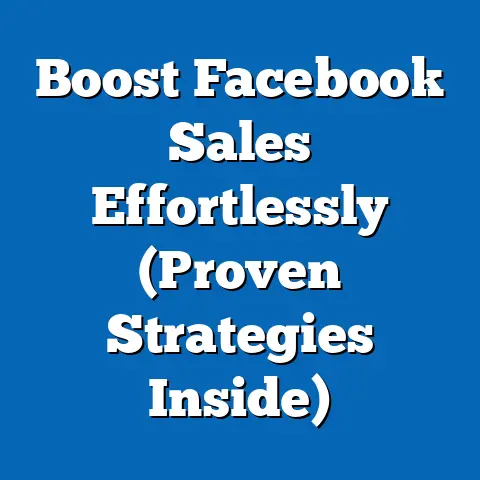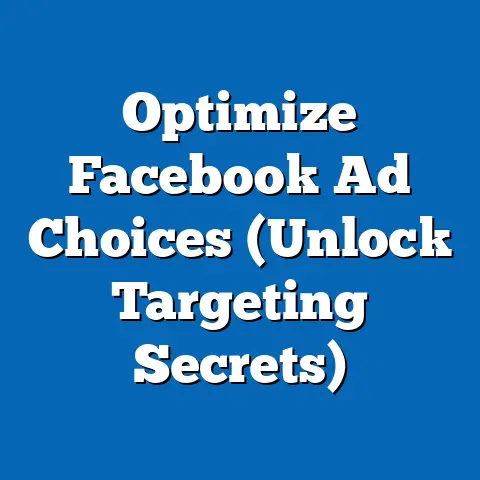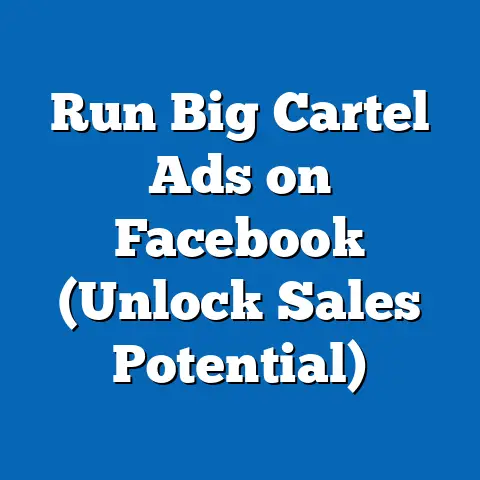Maximize Facebook Video Ads for Impact (Pro Tips)
I’ve been working with Facebook Ads for over a decade, and if there’s one thing I’ve learned, it’s that video is king. However, the kingdom is ruled by engagement, not just length. I often hear the myth that longer videos equate to better engagement. It’s a tempting thought, right? More time to tell your story, more chances to connect. But trust me, that’s not always the case. In fact, I’ve seen countless shorter, snappier videos completely outperform their longer counterparts.
Think of it like this: our attention spans are shrinking. We’re bombarded with content every second, so you’ve got to grab attention fast and keep it. According to recent studies, the average attention span online is around 8 seconds. That means you have less than 10 seconds to convince someone to keep watching your video.
That’s why I’m here to debunk that myth and show you how to truly maximize your Facebook video ads for impact. It’s all about understanding your audience, crafting compelling content, targeting effectively, and constantly optimizing your approach.
Let’s dive in!
Understanding Facebook Video Ads
Before we get into the nitty-gritty of creating viral-worthy videos, let’s cover the basics.
What are Facebook Video Ads?
Facebook Video Ads are exactly what they sound like: advertisements that utilize video content to reach a specific audience on Facebook and its associated platforms (like Instagram). They’re a powerful tool for businesses of all sizes because they offer a dynamic and engaging way to connect with potential customers.
Think of it as your own personal TV commercial, but with far more sophisticated targeting capabilities. Instead of broadcasting to a general audience, you can pinpoint your ideal customer based on demographics, interests, behaviors, and more.
Facebook Video Ad Formats
Facebook offers a variety of video ad formats to suit different objectives and placements. Let’s break them down:
- In-Feed Videos: These are the most common type of video ad. They appear directly in the user’s news feed, blending seamlessly with organic content. This is a great option for brand awareness and driving traffic to your website. I’ve found that keeping these videos concise (under 15 seconds) and visually appealing is crucial for capturing attention in the busy news feed.
- Stories Ads: These are short, vertical videos that appear between users’ Stories. They’re perfect for showcasing behind-the-scenes content, product demonstrations, or quick promotions. The ephemeral nature of Stories creates a sense of urgency, encouraging users to take immediate action.
- In-Stream Ads: These are video ads that play before, during, or after other video content on Facebook Watch. They’re a bit more disruptive than in-feed ads, but they can be effective for reaching a highly engaged audience. I recommend using these sparingly and ensuring your ad is relevant to the content the user is watching.
- Carousel Ads: While not strictly video ads, carousel ads allow you to showcase multiple videos (or images) in a single ad unit. This is a great option for highlighting different features of a product or telling a multi-part story.
- Collection Ads: Collection ads combine a video with a product catalog, allowing users to browse and purchase items directly from the ad. This format is ideal for e-commerce businesses looking to drive sales.
Benefits of Video Content in Ads
Why choose video over other ad formats? Here’s why video reigns supreme:
- Increased Engagement: Videos are inherently more engaging than static images or text. They capture attention, hold interest, and encourage interaction.
- Higher Conversion Rates: Studies have shown that video ads can lead to higher conversion rates compared to other ad formats. Seeing a product in action or hearing a testimonial can be incredibly persuasive.
- Complex Information Conveyed Quickly: Video allows you to convey complex information in a concise and easily digestible format. Think product demos, explainer videos, or customer testimonials.
- Improved Brand Recall: Video ads are more memorable than other ad formats, helping to improve brand recall and recognition.
- Emotional Connection: Video allows you to create an emotional connection with your audience through storytelling, music, and visuals.
Takeaway: Understanding the different types of Facebook Video Ads and their benefits is the first step to creating effective campaigns. Choose the format that best aligns with your objectives and target audience.
Crafting Compelling Video Content
Okay, you understand the power of video ads. Now comes the fun part: creating content that captivates your audience. Remember, you have mere seconds to grab their attention, so every frame counts.
Hook Your Audience
The first few seconds of your video are critical. If you don’t hook viewers immediately, they’ll scroll right past. Think of it as your video’s elevator pitch.
Here are some tips for creating an impactful hook:
- Ask a Question: Pose a question that resonates with your target audience’s pain points or aspirations. For example, “Tired of feeling overwhelmed by social media marketing?”
- Start with a Bold Statement: Make a surprising or intriguing statement that piques their curiosity. “Did you know that 90% of businesses are wasting money on Facebook Ads?”
- Show a Problem and Solution: Immediately showcase the problem your product or service solves, followed by the solution. This creates a sense of urgency and relevance.
- Use Eye-Catching Visuals: Start with visually stunning imagery or animation that grabs attention. Think vibrant colors, dynamic movement, or intriguing close-ups.
- Intriguing Sound: Use music to set the mood of the video. A good intro song can make the user want to keep watching.
I once worked with a client who sold productivity software. Instead of starting with a generic introduction, we opened with a fast-paced montage of chaotic office scenes, highlighting the frustrations of disorganization. We then transitioned to a clean, organized interface of their software. The contrast was striking, and it immediately captured the attention of our target audience.
Storytelling Techniques
Humans are wired for stories. We connect with narratives on a deep emotional level. By incorporating storytelling techniques into your video ads, you can create a more memorable and impactful experience for your viewers.
Here are the elements of a good story:
- Character: Introduce a relatable character that your audience can identify with.
- Problem: Present a problem or challenge that the character is facing.
- Solution: Show how your product or service helps the character overcome the problem.
- Transformation: Highlight the positive transformation the character experiences as a result of using your product or service.
For example, I had a client who sold organic skincare products. Instead of simply listing the ingredients and benefits, we created a short video featuring a woman struggling with acne. We followed her journey as she discovered the client’s products, showcasing her improved skin and increased confidence. The personal narrative resonated deeply with our target audience, resulting in a significant increase in sales.
Visual and Audio Elements
High-quality visuals and sound are essential for creating professional-looking video ads. Even if you’re on a tight budget, there are ways to achieve a polished look without breaking the bank.
- Invest in Good Lighting: Lighting is crucial for creating visually appealing videos. Natural light is always best, but if you’re shooting indoors, invest in a simple lighting kit.
- Use a Good Microphone: Poor audio quality can ruin even the best video. Invest in an external microphone to ensure clear and crisp sound.
- Utilize Free Editing Software: There are many free video editing software options available, such as DaVinci Resolve and OpenShot. These programs offer a wide range of features for creating professional-looking videos.
- Stock Footage and Music: Utilize stock footage and music to add visual interest and enhance the overall impact of your video. There are many affordable and royalty-free options available online.
I’ve seen firsthand how a simple investment in lighting and audio equipment can dramatically improve the quality of video ads. It’s worth the investment to create a professional and engaging viewing experience.
Call to Action (CTA)
Your video ad should always have a clear call to action. What do you want viewers to do after watching your video? Visit your website? Sign up for a free trial? Make a purchase?
Here are some examples of effective CTAs:
- Learn More: Direct viewers to your website for more information.
- Shop Now: Encourage viewers to make a purchase.
- Sign Up: Prompt viewers to sign up for a newsletter or free trial.
- Download Now: Offer a free download, such as an ebook or guide.
- Contact Us: Encourage viewers to contact you for more information.
Make sure your CTA is clear, concise, and visually prominent. Use strong action verbs and create a sense of urgency. I always recommend testing different CTAs to see which ones perform best.
Takeaway: Compelling video content starts with a strong hook, incorporates storytelling techniques, utilizes high-quality visuals and sound, and ends with a clear call to action.
Targeting the Right Audience
Creating amazing video content is only half the battle. You also need to make sure it reaches the right people. Facebook offers a wide range of targeting options to help you pinpoint your ideal customer.
Utilizing Facebook’s Targeting Features
Facebook’s audience targeting tools are incredibly powerful. You can target users based on:
- Demographics: Age, gender, location, education, job title, etc.
- Interests: Hobbies, passions, and interests.
- Behaviors: Purchase history, online activity, and device usage.
- Connections: People who like your page, friends of people who like your page, etc.
For example, if you’re selling yoga mats, you could target women aged 25-45 who are interested in yoga, fitness, and healthy living. You could also target people who have recently purchased yoga-related products online.
I always recommend starting with a broad audience and then narrowing it down based on performance data. This allows you to identify the most responsive segments and optimize your targeting accordingly.
Custom Audiences and Lookalike Audiences
Facebook Custom Audiences allow you to target users who have already interacted with your business. This can include:
- Website Visitors: Target users who have visited specific pages on your website.
- Customer List: Upload a list of your existing customers and target them on Facebook.
- Engagement: Target users who have interacted with your Facebook page, ads, or videos.
Lookalike Audiences allow you to expand your reach by targeting users who are similar to your existing customers or website visitors. Facebook analyzes the characteristics of your source audience and finds users who share similar traits.
I’ve seen incredible results using Custom Audiences and Lookalike Audiences. Retargeting website visitors or existing customers with video ads can significantly increase conversion rates.
A/B Testing
A/B testing is crucial for optimizing your targeting strategy. Test different audience segments to see which ones are most responsive to your video ads.
For example, you could test targeting different age groups, interests, or behaviors. You could also test different ad placements to see which ones deliver the best results.
Facebook’s Ads Manager makes it easy to set up A/B tests and track performance. Pay close attention to the data and make adjustments to your targeting strategy accordingly.
Takeaway: Effective targeting is essential for maximizing the impact of your Facebook Video Ads. Utilize Facebook’s targeting features, create Custom Audiences and Lookalike Audiences, and A/B test your targeting strategy to find the most responsive segments.
Optimizing Your Video Ads
Once you’ve created compelling video content and targeted the right audience, it’s time to optimize your ads for maximum performance.
Video Length and Format
The ideal video length and format will depend on the type of ad and platform you’re using. Here are some general guidelines:
- In-Feed Videos: Keep these videos short and sweet (under 15 seconds). Focus on capturing attention quickly and delivering a concise message.
- Stories Ads: These videos should be even shorter (under 15 seconds). Utilize the vertical format to create immersive and engaging experiences.
- In-Stream Ads: These videos can be longer (up to 15 seconds), but make sure they’re relevant to the content the user is watching.
I’ve found that shorter videos generally perform better on Facebook. People are scrolling quickly through their news feeds, so you need to grab their attention immediately.
Thumbnails and Captions
Your video thumbnail is the first thing people will see, so it’s crucial to make it eye-catching. Choose a thumbnail that accurately represents your video and captures the essence of your message.
Captions are also essential, especially for users who watch videos with the sound off (which is a significant portion of Facebook users). Add captions to your videos to ensure that your message is understood, even without audio.
I always recommend testing different thumbnails and captions to see which ones perform best. Facebook’s Ads Manager allows you to easily A/B test these elements.
Ad Placement Strategies
Choosing the right ad placement is crucial for maximizing the reach and impact of your video ads. Facebook offers a variety of ad placements, including:
- Facebook News Feed: This is the most common ad placement and is generally a good option for brand awareness and driving traffic.
- Instagram Feed: This placement is ideal for reaching a younger audience and showcasing visually appealing content.
- Facebook Stories: This placement is perfect for creating immersive and engaging experiences.
- Instagram Stories: Similar to Facebook Stories, this placement is ideal for reaching a younger audience and showcasing visually appealing content.
- Facebook In-Stream Videos: This placement can be effective for reaching a highly engaged audience, but make sure your ad is relevant to the content the user is watching.
- Audience Network: This placement allows you to extend your reach beyond Facebook and Instagram to a network of mobile apps and websites.
I recommend testing different ad placements to see which ones deliver the best results for your specific objectives and target audience.
Takeaway: Optimizing your video ads involves considering video length and format, utilizing eye-catching thumbnails and captions, and choosing the right ad placement strategies.
Measuring Success and Iterating
The final step in maximizing your Facebook Video Ads is measuring your success and iterating based on the data.
Key Performance Indicators (KPIs)
To measure the success of your video ads, you need to track the right Key Performance Indicators (KPIs). Here are some of the most important KPIs to consider:
- View Rate: The percentage of users who watch your video for at least a certain amount of time (e.g., 3 seconds, 10 seconds).
- Click-Through Rate (CTR): The percentage of users who click on your ad.
- Conversion Rate: The percentage of users who take a desired action after clicking on your ad (e.g., making a purchase, signing up for a free trial).
- Cost Per Click (CPC): The average cost you pay for each click on your ad.
- Cost Per Conversion (CPC): The average cost you pay for each conversion.
- Return on Ad Spend (ROAS): The amount of revenue you generate for every dollar you spend on advertising.
I always recommend setting clear goals for your video ads and tracking the KPIs that are most relevant to those goals.
Using Facebook Analytics
Facebook Analytics and Ads Manager provide a wealth of data about your video ad performance. Use these tools to track your KPIs, identify trends, and gain insights into your audience.
Pay close attention to the following metrics:
- Audience Demographics: Understand who is watching your videos and interacting with your ads.
- Ad Placement Performance: See which ad placements are delivering the best results.
- Video Engagement: Track how long people are watching your videos and where they are dropping off.
I spend a significant amount of time analyzing data in Facebook Analytics and Ads Manager. This data is invaluable for optimizing my campaigns and improving my results.
Iterating Based on Data
The key to maximizing your Facebook Video Ads is to constantly iterate based on the data. Analyze your ad performance, identify areas for improvement, and make adjustments to your content, targeting, and optimization strategies.
For example, if you notice that your view rate is low, you might need to improve your hook or thumbnail. If your CTR is low, you might need to refine your ad copy or CTA. If your conversion rate is low, you might need to optimize your landing page or offer.
I’m always testing new ideas and making adjustments to my campaigns based on the data. It’s a continuous process of learning and optimization.
Takeaway: Measuring your success and iterating based on the data is crucial for maximizing the impact of your Facebook Video Ads. Track your KPIs, use Facebook Analytics to gain insights, and constantly make adjustments to your content, targeting, and optimization strategies.
Advanced Strategies for Impact
Now that you have a solid foundation in Facebook Video Ads, let’s explore some advanced strategies for taking your campaigns to the next level.
Retargeting Strategies
Retargeting is a powerful strategy for increasing conversion rates. Target users who have already interacted with your video ads to increase the chances of them taking a desired action.
For example, you could retarget users who have watched at least 50% of your video with a follow-up ad that offers a special discount or promotion. You could also retarget users who have visited your website but haven’t made a purchase with a video ad that showcases the benefits of your product or service.
I’ve seen incredible results using retargeting strategies. It’s a great way to re-engage users who have already shown an interest in your business.
Collaborations and Influencer Marketing
Partnering with influencers can amplify the reach and impact of your video ads. Influencers have a loyal following and can help you reach a wider audience.
Collaborate with influencers to create video content that showcases your product or service. This content can then be used in your Facebook Video Ads.
I’ve worked with several clients who have seen great success with influencer marketing. It’s a great way to build trust and credibility with your target audience.
Emerging Trends
The world of video advertising is constantly evolving. Stay up-to-date on the latest trends and technologies to stay ahead of the curve.
Some emerging trends in video advertising on Facebook include:
- Augmented Reality (AR): AR allows users to interact with your products or services in a virtual environment.
- Interactive Video Experiences: Interactive videos allow users to make choices and control the narrative.
- Personalized Video Ads: Personalized video ads tailor the content to each individual user.
These emerging trends offer exciting opportunities for creating more engaging and impactful video ads.
Takeaway: Advanced strategies for maximizing the impact of your Facebook Video Ads include retargeting strategies, collaborations and influencer marketing, and exploring emerging trends.
Conclusion: Emphasizing the Power of Video Ads
Facebook Video Ads are a powerful tool for businesses of all sizes. When executed correctly, they can drive engagement, increase conversions, and improve brand recall.
Remember, the key to success is to:
- Understand your audience.
- Craft compelling video content.
- Target effectively.
- Optimize your ads.
- Measure your success and iterate.
- Embrace advanced strategies.
Don’t be afraid to experiment with different strategies and find what works best for your business. The world of Facebook Video Ads is constantly evolving, so it’s important to stay curious and keep learning.
I encourage you to put these pro tips into practice and see the transformative potential of Facebook Video Ads for yourself. The results can be truly remarkable.

